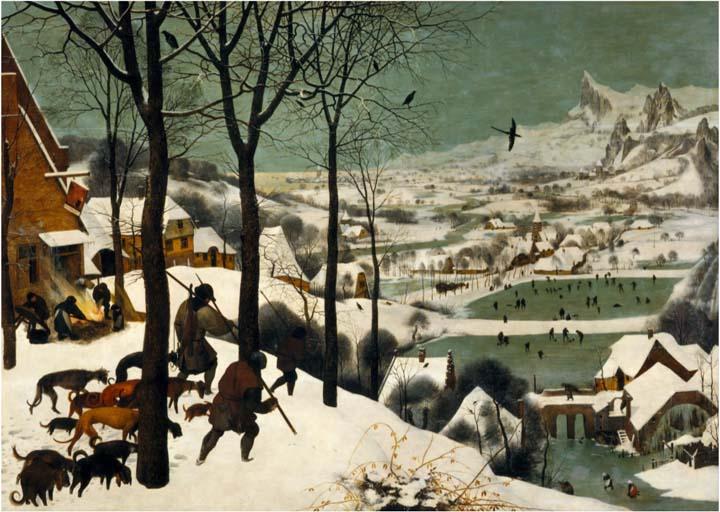Everybody Loves Breugel
Hunters in the Snow; Pieter Breugel the Elder (1565); Royal Museums
of Fine Arts of Belgium
Whenever I think of Breugel, an image of Hunters in the Snow, his 1565 masterpiece, materializes in my mind’s eye. Perhaps it’s the ice skaters gliding in ones and twos over frozen ponds in the middle distance—doppelgangers from the view that unfolded nearly every winter day after school in my childhood—that transports me. Although Bruegel painted this scene 400 years before my own skating days, the painting depicts village life in somewhat the way we lived it. The rural landscape, with its planting fields, barns and churches was similar, if less rocky than Bruegel’sview. My hometown was a farming community, and its daily activities were always part of the sensory gift from the landscape, although trucks and tractors eased the workload. For me, this painting never fails to conjure up the crisp scent of winter’s first snowfall, and heady anticipation of the oncoming Christmas holiday.
The Harvesters; Pieter Breugel the Elder (1565); TheMetropolitan Museum of
Art
There is something about the art of Pieter Breugel the Elder (1525-1569) that evokes a finite world in every one of his paintings. As Jonathan Jones recently wrote in The Guardian, ”Bruegel’s art is simply more human and generous that anyone else’s. Rembrandt? Picasso? They’re so self-obsessed. Bruegel paints you and me and everyone. In that snow scene he made in 1563 [sic], it takes a while to recognise any narrative or symbolism at all. Only on close inspection can you see, through the falling snowflakes, the visitors abasing themselves before a woman and her baby. This is an Adoration of the Magi.”
Currently on view at Vienna’s Kunsthistorisches Museum is a blockbuster show of the 16th-century Flemish artist's work that collects 30 of the 40 paintings he made over his lifetime that have survived) from across Europe, and 60 drawings. Among these are The Triumph of Death (below)—considered Breugel's ultimate masterpiece—from the Prado in Madrid. Luckily for New Yorkers, The Harvesters (above) remains at The Met as it’s too fragile to be lent. Also in New York is The Three Soldiers, a grisaille sketch from 1568, at The Frick Collection. This small panel, once in the collection of King Charles I of England, represents three Landsknechte, the German mercenary foot soldiers whose picturesque costumes and swashbuckling style provided popular images for printmakers in the sixteenth century.
The Triumph of Death, Pieter Breugel the
Elder (c1562); Museo Nacional del Prado
For those who won’t be traveling to Vienna, there are many online resources that offer images and information about Breugel. Chief among them is Google Arts & Culture’s feature, Breugel and His Time. Organized by Jean-Philippe Theyskens, of the Royal Museums of Fine Arts of Belgium, the feature offers a snapshot of one of the most complex periods in the history, and the history of the art of the Netherlands during Bruegel’s time—and sheds light on why this artist is such a timeless painter. Additional features on Breugel from the RMFAB are also accessible through Google Arts & Culture.





